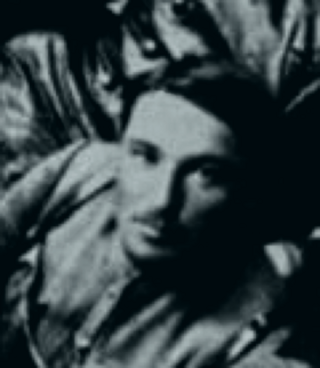
Semen Mykytovych Karetnyk was a Ukrainian anarchist and a commander of the Revolutionary Insurgent Army of Ukraine (RIAU). He often replaced Nestor Makhno as supreme commander of the Insurgent Army in 1920. Karetnyk gained a reputation for his central role in defeating the White Army in Crimea in November 1920.

The Revolutionary Insurgent Army of Ukraine, also known as Makhnovtsi, named after their leader Nestor Makhno, was an anarchist army formed largely of Ukrainian peasants and workers during the Russian Civil War of 1917–1922. They protected the operation of "free soviets" and libertarian communes by the Makhnovshchina, an attempt to form a stateless anarcho-communist society from 1918 to 1921 during the Ukrainian War of Independence.

Panteleimon "Panteley" Fyodorovich Belochub, , was a Ukrainian soldier best known as one of the commanders of the Revolutionary Insurgent Army of Ukraine, a major belligerent force during the Russian Civil Wars of 1917 – 1921.
The 2nd Azov Corps was a military formation of the Revolutionary Insurgent Army of Ukraine, one of the 4 corps that was created on 1 September 1919, and existed until 1920.
The 6th Kyiv Corps was a military formation of the Revolutionary Insurgent Army of Ukraine, one of 4 corps which was created in October 1919 and existed until 1920.
The 9th Greek Regiment was a regiment that was part of the 3rd Infantry Brigade of the 1st Zadneprovskaya Ukrainian Soviet Division, formed on the basis of the Greek detachments of the Revolutionary Insurgent Army of Ukraine in February 1919.

The Air Fleet of the Revolutionary Insurgent Army of Ukraine was one of the branches of the Revolutionary Insurgent Armed Forces.

The 1st Zadneprovskaya Ukrainian Soviet Division was a military unit of the Ukrainian Soviet Army during the Russian Civil War.
Tymofiy Lashkevych was a Ukrainian anarcho-communist that fought with the Makhnovists during the Ukrainian War of Independence as commander of the 1st Donetsk Corps.
Oleksandr Kalashnykov was a Ukrainian anarchist and a commander of the 1st Donetsk Corps of the Revolutionary Insurgent Army of Ukraine.
Mikhail Uralov was a Russian anarchist, the head of the "Black Guard" combat units of the Moscow Federation of Anarchists ,and a commander of the Revolutionary Insurgent Army of Ukraine.
The Azov-Black Sea Flotilla was a formation of the Makhnovist fleet, the main area of which was the Sea of Azov.
Hryhorii Ivanovych Makhno was a Ukrainian rebel commander and brother of Nestor Makhno.
Grigory Savelievich Maslakov, "Maslak" (1877-1921) was a Russian military leader during the Russian Civil War.
Oleksiy Vasylovych Chubenko was a diplomat for the Revolutionary Insurgent Army of Ukraine.
Vasyl Mikhailovych Sharovsky was a member of the Central Council of Ukraine, an anarcho-communist and an artillery commander of the Revolutionary Insurgent Army of Ukraine.

Foma Kozhyn was a Ukrainian revolutionary and the commander of the machine-gun regiment of the Revolutionary Insurgent Army of Ukraine.

Vasyl Kurylenko was a commander in the Revolutionary Insurgent Army of Ukraine.
The Bolshevik–Makhnovist conflict was a period of political and military conflict between the Ukrainian Soviet Socialist Republic and the Makhnovshchina, for control over southern Ukraine. The Bolsheviks aimed to eliminate the Makhnovshchina and neutralise its peasant base. In turn, the Makhnovists fought against the implementation of the Red Terror and the policy of war communism.
Luka Nykyforovych Bondarets was the cavalry commander of the Revolutionary Insurgent Army of Ukraine (RIAU).







